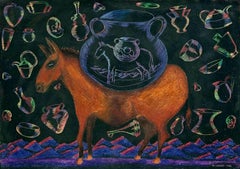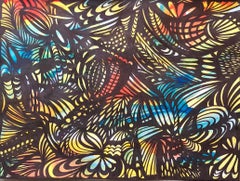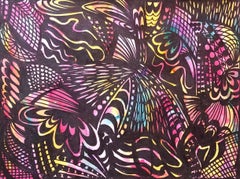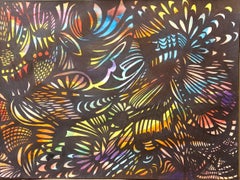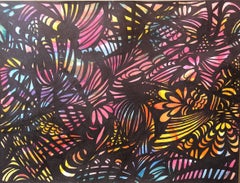Lions Gallery Drawings and Watercolor Paintings
Mid-20th Century Expressionist Figurative Drawings and Watercolors
Paper, Watercolor
1980s Contemporary Figurative Drawings and Watercolors
Oil Crayon, Wax Crayon
Early 2000s Abstract Expressionist Abstract Drawings and Watercolors
Paper, Ink, Watercolor, Permanent Marker
Early 2000s Abstract Expressionist Abstract Drawings and Watercolors
Paper, Ink, Watercolor, Permanent Marker
Early 2000s Abstract Expressionist Abstract Drawings and Watercolors
Paper, Ink, Watercolor, Permanent Marker
Early 2000s Abstract Expressionist Abstract Drawings and Watercolors
Paper, Ink, Watercolor, Permanent Marker
Early 2000s Abstract Expressionist Abstract Drawings and Watercolors
Paper, Ink, Watercolor, Permanent Marker
Early 20th Century Post-Impressionist Figurative Paintings
Paper, Oil Pastel, Oil
20th Century Expressionist Landscape Drawings and Watercolors
Paper, Oil Pastel, Pastel
21st Century and Contemporary Outsider Art Figurative Paintings
Oil Pastel, Archival Paper
Late 20th Century American Modern Figurative Drawings and Watercolors
Mixed Media
Late 20th Century Abstract Figurative Drawings and Watercolors
Mixed Media
1930s Naturalistic Figurative Drawings and Watercolors
Archival Ink, Watercolor, Illustration Board
1990s Outsider Art Figurative Drawings and Watercolors
Paper, India Ink
1980s 85 New Wave Abstract Drawings and Watercolors
Conté, Charcoal, Gouache, Rag Paper, Graphite
20th Century Conceptual Mixed Media
Mixed Media, Monoprint, Monotype
20th Century Conceptual Mixed Media
Mixed Media, Monoprint, Monotype
20th Century Conceptual Mixed Media
Mixed Media, Monoprint, Monotype
20th Century Conceptual Mixed Media
Mixed Media, Monoprint, Monotype
20th Century Conceptual Mixed Media
Mixed Media, Monoprint, Monotype
20th Century Conceptual Mixed Media
Mixed Media, Monoprint, Monotype
20th Century Conceptual Mixed Media
Mixed Media, Monoprint, Monotype
20th Century Conceptual Mixed Media
Mixed Media, Monoprint, Monotype
20th Century Conceptual Mixed Media
Mixed Media, Monoprint, Monotype
20th Century Conceptual Mixed Media
Mixed Media, Monoprint, Monotype
20th Century Conceptual Mixed Media
Mixed Media, Monoprint, Monotype
1930s Naturalistic Figurative Drawings and Watercolors
Archival Ink, Watercolor, Illustration Board
1930s American Modern Figurative Drawings and Watercolors
India Ink, Watercolor, Illustration Board
1990s Pop Art Figurative Drawings and Watercolors
Charcoal, Pastel
20th Century Modern Figurative Drawings and Watercolors
Watercolor
20th Century Modern Portrait Drawings and Watercolors
Paper, Etching
Mid-20th Century Modern Landscape Drawings and Watercolors
Paper, Watercolor
1950s Modern Figurative Drawings and Watercolors
India Ink, Watercolor
Mid-20th Century American Modern Abstract Paintings
India Ink, Paper
1940s American Modern Figurative Drawings and Watercolors
Paper, Oil Pastel
Late 20th Century Contemporary Figurative Drawings and Watercolors
Paper, Pastel
1970s Contemporary Figurative Drawings and Watercolors
Paper, Pencil
Early 2000s Neo-Expressionist Nude Drawings and Watercolors
Paper, Charcoal
Late 20th Century Modern Nude Drawings and Watercolors
Paper, Ink
Mid-20th Century American Modern Figurative Drawings and Watercolors
Watercolor
1980s Contemporary Figurative Drawings and Watercolors
Paper, Ink
Late 20th Century Modern Abstract Drawings and Watercolors
Conté, Charcoal, Crayon, Mixed Media
21st Century and Contemporary Contemporary Abstract Drawings and Waterco...
Paper, Watercolor
Mid-20th Century American Modern Figurative Paintings
Paper, Watercolor
20th Century Abstract Abstract Drawings and Watercolors
Watercolor, Archival Paper
20th Century Abstract Abstract Drawings and Watercolors
Watercolor, Archival Paper
Mid-20th Century Expressionist Drawings and Watercolor Paintings
Ink
21st Century and Contemporary Contemporary Drawings and Watercolor Paint...
Ink, Pen
20th Century Modern Drawings and Watercolor Paintings
Watercolor
20th Century Modern Still-life Drawings and Watercolors
Paper, Oil Pastel
1950s Figurative Drawings and Watercolors
Chalk, Pastel
Mid-20th Century Modern Figurative Drawings and Watercolors
Paper, Ink
20th Century Modern Portrait Drawings and Watercolors
Watercolor
20th Century Modern Figurative Drawings and Watercolors
Paper, Pencil
Early 20th Century Modern Figurative Drawings and Watercolors
Paper, Ink
1970s Expressionist Figurative Drawings and Watercolors
Watercolor
Mid-20th Century Abstract Expressionist Abstract Drawings and Watercolors
Watercolor
20th Century Modern Animal Drawings and Watercolors
Watercolor
Late 20th Century Abstract Abstract Drawings and Watercolors
Paper, Ink
Late 20th Century Contemporary Figurative Drawings and Watercolors
Paper, Pastel, Pencil

